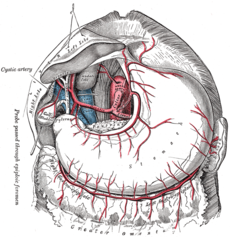- Dieulafoy's lesion
-
Dieulafoy's lesion Classification and external resources 
Blood supply of stomachICD-10 K25 ICD-9 537.84 DiseasesDB 33135 Dieulafoy's lesion (exulceratio simplex Dieulafoy) is a medical condition characterized by a large tortuous arteriole in the stomach wall that erodes and bleeds. It can cause gastric hemorrhage[1] but is relatively uncommon. It is thought to cause less than 5% of all gastrointestinal bleeds in adults. It was named after French surgeon Paul Georges Dieulafoy, who described this condition in his paper "Exulceratio simplex: Leçons 1-3" in 1898.[2][3] It is also called "caliber-persistent artery" or "aneurysm" of gastric vessels. However, unlike most other aneurysms these are thought to be developmental malformations rather than degenerative changes.
Contents
Presentation
Dieulafoy's Lesions are characterized by a single large tortuous arteriole in the submucosa which does not undergo normal branching or a branch with caliber of 1–5 mm (more than 10 times the normal diameter of mucosal capillaries). The lesion bleeds into the gastrointestinal tract through a minute defect in the mucosa which is not a primary ulcer of the mucosa but an erosion likely caused in the submucosal surface by protrusion of the pulsatile arteriole.
Approximately 75% of Dieulafoy's lesions occur in the upper part of the stomach within 6 cm of the gastroesophageal junction, most commonly in the lesser curvature. Extragastric lesions have historically been thought to be uncommon but have been identified more frequently in recent years, likely due to increased awareness of the condition. The duodenum is the most common location (14%) followed by the colon (5%), surgical anastamoses (5%), the jejunum (1%) and the esophagus (1%).[4] The pathology in these extragastric locations is essentially the same as that of the more common gastric lesion.
Interestingly and in contrast to peptic ulcer disease, a history of alcohol abuse or NSAID use is usually absent in DL.
Dieulafoy's lesions occur twice as often in men as women and patients typically have multiple comorbidities, including hypertension, cardiovascular disease, chronic kidney disease, and diabetes.
Symptoms
The symptoms due to bleeding are hematemesis and/or melena, possibly with shock.
Presenting Symptoms Recurrent hematemesis with melena 51% of cases Hematemesis without melena 28% of cases Melena with no hematemesis 18% of cases A Dieulafoy's lesion is difficult to diagnose, because of the intermittent pattern of bleeding. Endoscopically it is not easy to recognize and therefore sometimes multiple views have to be performed over a longer period. Today angiography is a good additional diagnostic, but then it can only be seen during a bleeding at that exact time.
Treatment
It is diagnosed and treated endoscopically, however endoscopic ultrasound or angiography can be of benefit.
Endoscopic techniques used in the treatment include epinephrine injection followed by bipolar electrocoagulation, monopolar electrocoagulation, injection sclerotherapy, heater probe, laser photocoagulation, hemoclipping or banding.
Prognosis
The mortality rate for Dieulafoy's was much higher before the era of endoscopy, where open surgery was the only treatment option.
References
- ^ Akhras J, Patel P, Tobi M (March 2007). "Dieulafoy's lesion-like bleeding: an underrecognized cause of upper gastrointestinal hemorrhage in patients with advanced liver disease". Dig. Dis. Sci. 52 (3): 722–6. doi:10.1007/s10620-006-9468-7. ISBN 1062000694687. PMID 17237996.
- ^ synd/3117 at Who Named It?
- ^ G. Dieulafoy. Exulceratio simplex: Leçons 1-3. In: G. Dieulafoy, editor: Clinique medicale de l'Hotel Dieu de Paris. Paris, Masson et Cie: 1898:1-38.
- ^ Lee Y, Walmsley R, Leong R, Sung J (2003). "Dieulafoy's Lesion". Gastrointestinal Endoscopy 58 (2): 236–243. doi:10.1067/mge.2003.328. PMID 12872092.
Categories:- Stomach disorders
Wikimedia Foundation. 2010.
